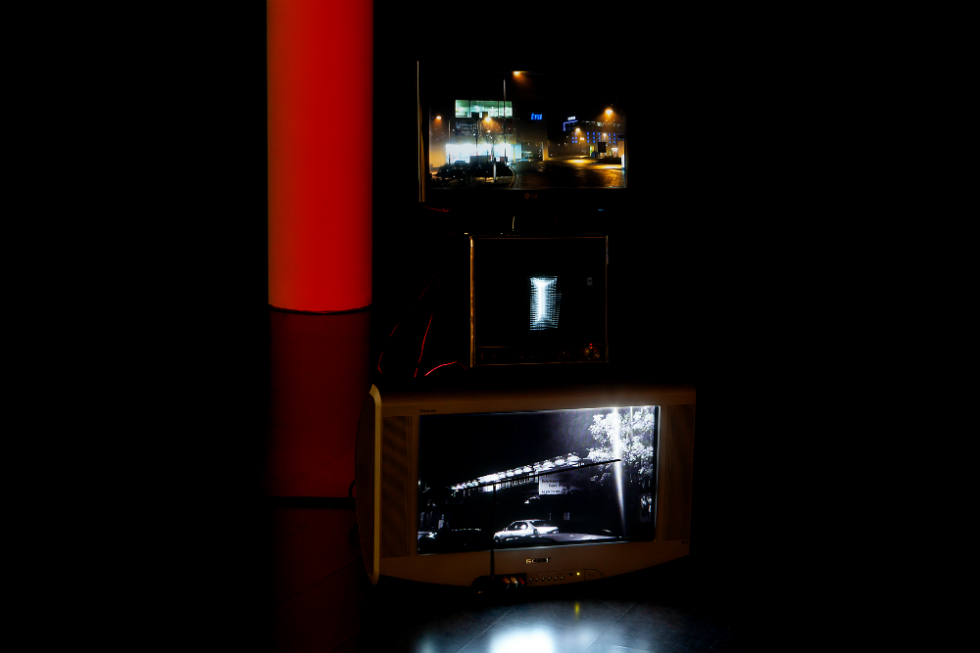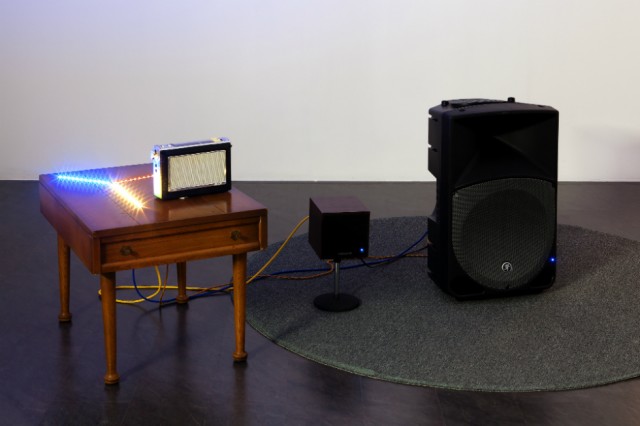Making Sense Of White Noise: Haroon Mirza

Haroon Mirza secured his first solo exhibition in Korea thanks to winning the Nam June Paik Art Center Prize. As the show comes to a close, jury member Mike Stubbs reflects on why he won, and the electro-magnetic forces at the heart of his work…
In selecting Haroon Mirza for the 2014 Nam June Paik Art Center Prize, the jury chose this artist for his ability to consistently extend a practice, which continues a fascination with media, time and transmission. Much like Nam June Paik, similarly speaking beyond cultures, language and belief.
It is this continuing belief in art as a fictive realm, rather than as existing in service to ‘progress’, that has enabled art to push our boundaries, conceptually, politically and intellectually. The license, with which we give artists, both expresses societies reflexive maturity, and allows increasingly ephemeral objects to gain value in our minds and markets.
Sometimes incorporating found familiar household electrical devices such as record decks, transistor radios, desk lamps and loudspeakers, Mirza’s works resonate the voice of Dadaism exploring electro-magnetic forces at a human scale. Artworks and performances that maintain an open-ness to universal conditions, material circumstances and perception, which sharpen our senses through a synesthetic direct art experience, there by invoking ontology.
Earlier work especially incorporating found vintage objects seem imbued with a ‘sentimental’ memory through their patina and our own cultural references of them. Nam June Paik might have enjoyed these re-combinations of homely devices as a proto-hacker himself fascinated with changing objects and their outputs to form new functions and relationships. Nam June Paik experimented with video synthesizers, performance and television, bringing together new sets of knowledge and technologies. His artwork not only referenced the new televisual era through the sculptural and kinetic values of the TV set, but also exploited the potential of the globalized network itself and the noise (ghost) in the machine. I suspect Nam June Paik would have enjoyed the playful re-combinations of homely devices found in Mirza’s work.
After the Second World War, the remnants of an industrial economy and a modernist belief in technology as a solution, combined with imagination and a surplus of the leftover machines of fighting, provided the correct conditions for experiment. Science and technology entered hobbyism: wireless, the radio ham, model aircraft combined with the essential past time of small scale construction and electrical engineering, learned from a culture of wartime invention. Fathers, tinkering in sheds. Nam Jun Paik’s own father, a textile mill owner, would probably have understood invention through trade and chemistry and maybe forms influence and a reactive virtuous circle through his own son’s practice. Though converting devices, for artistic purposes; perhaps the overhang of war-time habits, of needs, into arts practice reflective, precursor to our current maker/hacker culture and antidote to ‘innovation’.
The physicality of much of the work by Mirza, sculptural and sonic, is both playful and critical expressing a need to make the invisible, visible, and hence a deep need for material engagement and the tangible. Yet, rather than making things seamless, Mirza prefers to deconstruct with a humour and fuelled by a desire to physically manifest the un-see able in space.

If the work of Art can be thought of as a fiction — as an obscurified and predictive form, one that balances upon the cusp of reality — then the artist, by their own criteria, examines an existing subject and passes judgement upon how this should be re-formed, or on how things ought to be. This outcome is imagined and fictitious, but attains a perceived significance and potential for prescience through the reverence with which we have come to behold the work of Art. The role that the artist fulfils, of observing the world and interrogating its makeup, presents an opportunity to demonstrate the possibility of change; at the edge, where the infinite potentiality of the fictional bleeds into actuality.
We, the audience, are left with our own thoughts and experience building meaning through memory, sensation and embodied knowledge. Haroon Mirza reverses the utility and simple narratives, simultaneously invoking phenomena which we the audience can find as complex as we need. Work, which demands the imagination and completion by us, the audience, share a process of experiment in creating and re-mixing Mirza’s own audio-visual system, one of chance and unpredictability. Music is everywhere, if we listen sensitively enough we can here it now in our immediate noise field, be that white noise or a waterfall.
Mike Stubbs, Director FACT, Liverpool and Nam June Paik Art Center Prize Jury Member
The Circuits & Sequences exhibition, featuring new and recent works, is the first solo exhibition in Korea by the 2014 Nam June Paik Art Center Prize winner Haroon Mirza
See Circuits & Sequences at the Nam June Paik Art Center, Yongin-si, Gyeonggi-do, Korea, until 7 February 2016
Images, from top; Haroon Mirza, Tescotrain (Homage to Guy Sherwin) (2012), 3 TVs, 2 media players, Arduino, LED, relay internal dimensions 110cm x 50cm x 80cm. Courtesy hrm199 Ltd and Lisson Gallery. Photocredit: Nam June Paik Art Center/ Sindae Kang.
Haroon Mirza, Falling Rave (2014), wooden side table, circuitry control box, LED strips, mackie speaker, behringer speaker, radio (w)2m x (d)1m x (h)1m. Courtesy hrm199 Ltd and Lisson Gallery. Photocredit: Nam June Paik Art Center/ Sindae Kang
Feature image: Haroon Mirza, Solar Symphony Solar_Corb B, Solar Symphony Solar_Corb D (2014), solar panels, speakers, LEDs, electronics, dimensions variable. Courtesy hrm199 Ltd. and Lab’Bel. Photocredit: Nam June Paik Art Center/ Sindae Kang





